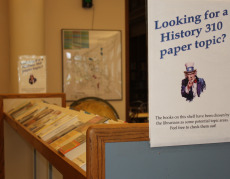We buy books on spec. Admittedly, it is well-considered and informed speculation, but it is speculation nonetheless. After six months, books are no longer considered “new” and are sent into the stacks. It upsets me when books enter the stacks without ever having circulated, because the odds of them being discovered when they are out of sight are much diminished. Thus, a dilemma for libraries is how to display new materials so that they are irresistible.
Lacking the appropriate furniture for physical displays, we have tried virtual solutions to this problem. For years we have produced monthly web pages featuring new fiction and new non-fiction materials. But it is a big leap from discovering a new book on the library web site to making the trip over to obtain the book. Most people want instant gratification, and for that, nothing can out perform a good physical display.
At the end of the fall term, we did some brainstorming around the question: Given that we can’t afford new furniture, what do we already have that can be used to promote our new materials? After much discussion, we decided to recycle our old index tables, which were in storage in the attic. They are not perfect. They are quite unattractive, actually. But we felt that in this case function trumped aesthetics. What they do have going for them is that they have a slanted top, at a convenient height for noticing books.
We loaded one of them up with new non-fiction materials, with topics ranging across the disciplines. Each of us chose a few titles from our assigned “liaison” areas for the display. The second display shelf is being used for thematic displays. The current display is targeted to students enrolled in History 310, who are presently coming up with topics for their research papers. The featured books are intended to spur topic ideas, across a wide range of interests.
Scanning the display and replenishing the titles has become part of our opening routine each morning. The books are flying off of the display shelves. Sometimes students look at the books in the library, sometimes they are checked out. Either way is OK with us. Our new materials are finding an audience. And now we are back to brainstorming how to achieve the same result with better-looking display shelving at an affordable cost.

 The OWHL is pleased to announce that we have just added 47,000 full-text electronic books to our collection. These academic titles are provided by ebrary, and are well aligned with our curriculum. Here are some reasons why we are so excited.
The OWHL is pleased to announce that we have just added 47,000 full-text electronic books to our collection. These academic titles are provided by ebrary, and are well aligned with our curriculum. Here are some reasons why we are so excited.





